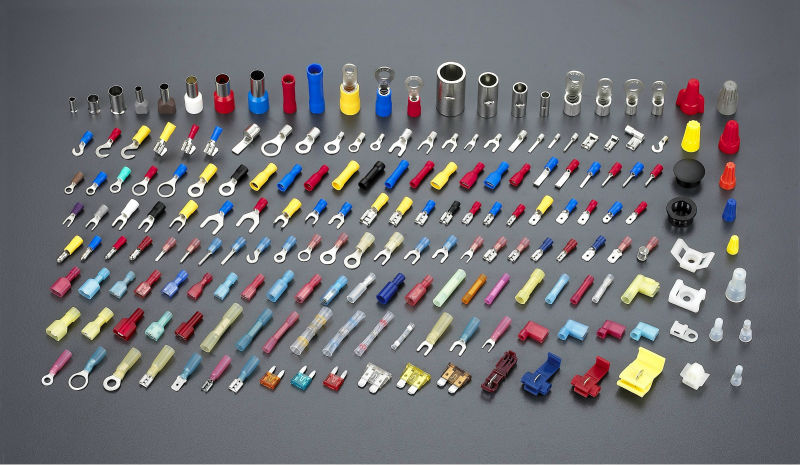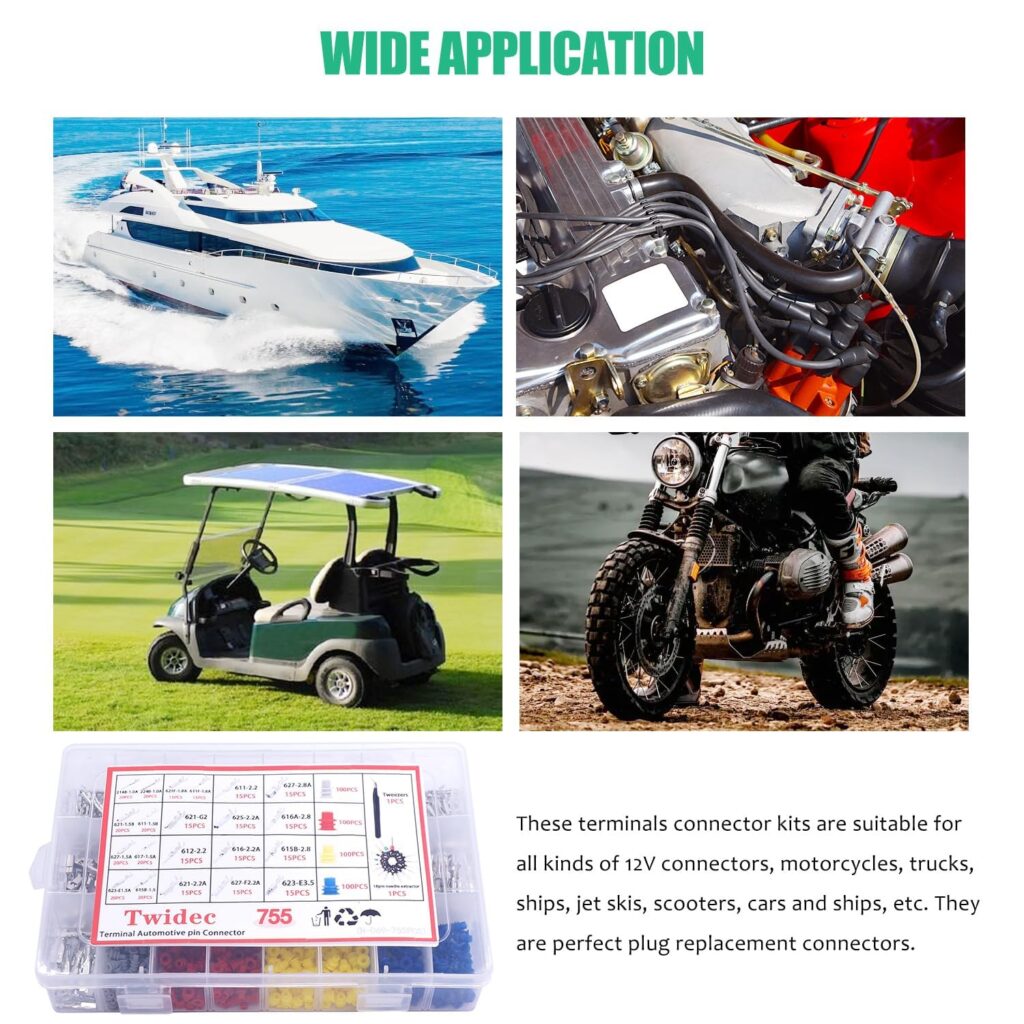Quick Answer: You should use insulated terminals when working with live electrical systems, in moisture-prone environments, around conductive surfaces, for voltage levels above 50V, or wherever electrical safety codes require additional protection against short circuits and electrocution hazards.
Choosing the right terminal type for your electrical connections directly impacts safety, code compliance, and system reliability. This comprehensive guide provides everything you need to know about when insulated terminals are essential versus optional, helping you make informed decisions that protect both people and equipment.
What Are Insulated Terminals? Key Definitions and Concepts

Insulated terminals are electrical connectors featuring a protective plastic or rubber sleeve covering the metal barrel and connection point. This insulation prevents accidental contact between the terminal and adjacent conductors, grounded surfaces, or human contact.
Non-insulated terminals (also called bare terminals) consist of exposed metal without protective covering, relying solely on proper installation spacing and environmental conditions for safety.
Key Components of Insulated Terminals:
- Metal barrel: Crimps onto wire for electrical connection
- Insulation sleeve: Plastic or rubber covering providing protection
- Connection point: Ring, spade, or other connector type
- Color coding: Indicates wire gauge compatibility and voltage ratings
Insulated vs. Non-Insulated Terminals: Complete Comparison Analysis
| Factor | Insulated Terminals | Non-Insulated Terminals |
|---|---|---|
| Safety Level | High – prevents accidental contact | Moderate – requires careful spacing |
| Cost | 15-25% more expensive | Lower initial cost |
| Installation Speed | Slightly slower due to bulk | Faster installation |
| Code Compliance | Required in many applications | Limited to specific conditions |
| Moisture Resistance | Excellent protection | Poor – exposed to corrosion |
| Space Requirements | Larger footprint needed | Compact installation possible |
| Visual Inspection | Harder to see connection quality | Easy connection verification |
| Temperature Rating | Typically -40°F to 221°F | Varies by metal type |
| Wire Gauge Range | Color-coded for easy selection | Requires careful sizing |
When You MUST Use Insulated Terminals: Safety and Code Requirements
Critical Safety Applications
You are required to use insulated terminals in these situations:
1. Live Electrical Work
- Any connection made on energized circuits
- Panel modifications without system shutdown
- Emergency repair situations requiring power continuity
2. High-Voltage Applications
- Circuits operating above 50 volts AC/DC
- Motor control centers and industrial equipment
- Commercial and industrial electrical systems
3. Moisture-Prone Environments
- Outdoor electrical connections
- Marine and automotive applications
- Basements, crawl spaces, and humid locations
4. Code-Required Installations
- National Electrical Code (NEC) Section 110.14 compliance
- OSHA electrical safety standards
- Local electrical code requirements
⚠️ Safety Warning
DANGER: Never use non-insulated terminals in live electrical work or high-voltage applications. Exposed metal can cause electrocution, equipment damage, or fires. When in doubt, always choose insulated terminals for maximum safety protection.
Specific Applications Where Insulated Terminals Excel

Industrial and Commercial Uses
- Motor control centers: Preventing short circuits in tight spaces
- Panel boards: Meeting NEC spacing requirements
- Control circuits: Protecting low-voltage signals from interference
- Junction boxes: Ensuring safe wire connections in confined areas
Automotive Applications
- Battery connections: Preventing accidental grounding
- Under-hood wiring: Protection from heat and moisture
- Trailer connections: Outdoor exposure protection
- Audio system installations: Preventing signal interference
Marine and Outdoor Projects
- Boat electrical systems: Corrosion and moisture protection
- Outdoor lighting: Weather-resistant connections
- Pool and spa equipment: Wet location safety requirements
- RV electrical systems: Vibration and moisture protection
How to Select the Right Insulated Terminal: Expert Decision Framework
Step 1: Determine Wire Gauge and Current Requirements
| Wire Gauge | Insulation Color | Max Current | Typical Applications |
|---|---|---|---|
| 22-16 AWG | Red | 15A | Control circuits, small motors |
| 16-14 AWG | Blue | 20A | General lighting, outlets |
| 12-10 AWG | Yellow | 30A | HVAC equipment, large appliances |
| 8 AWG and larger | No color standard | 40A+ | Service panels, large motors |
Step 2: Choose Connection Type
Ring Terminals: Secure, vibration-resistant connections for permanent installations
Spade Terminals: Quick-disconnect capability for maintenance access
Butt Connectors: Joining two wire ends with full insulation coverage
Hook Terminals: Easy installation on binding post connections
Step 3: Verify Environmental Requirements
- Standard PVC insulation: Indoor, dry locations (-40°F to 176°F)
- Heat-shrink insulation: Outdoor, moisture protection (-67°F to 257°F)
- Nylon insulation: High-strength, chemical resistance
- Vinyl insulation: General purpose, cost-effective option
Installation Best Practices and Safety Guidelines
Proper Crimping Technique
- Strip wire to match terminal barrel length (typically 1/4 to 3/8 inch)
- Insert wire fully into terminal barrel until insulation touches
- Crimp in center of barrel using proper crimping tool
- Inspect connection – wire should not pull out with moderate force
- Verify insulation coverage extends beyond metal barrel
🔧 Expert Tip
Professional Recommendation: Always use ratcheting crimp tools with proper die sets. Hand-squeeze crimpers often create unreliable connections that can fail over time, creating safety hazards and code violations.
Common Installation Mistakes to Avoid
- Insufficient wire stripping: Creates poor electrical connection
- Over-crimping: Damages wire strands and weakens connection
- Wrong terminal size: Leads to loose connections and overheating
- Mixing terminal types: Inconsistent connection quality and appearance
Troubleshooting Common Insulated Terminal Problems
Connection Overheating Issues
Symptoms: Discolored insulation, burning smell, terminal deformation
Causes: Undersized terminal, loose crimp, overloaded circuit
Solutions: Verify ampacity ratings, re-crimp connections, check circuit loading
Moisture Infiltration Problems
Symptoms: Corrosion, green deposits, connection resistance
Causes: Inadequate sealing, damaged insulation, condensation
Solutions: Use heat-shrink terminals, apply dielectric grease, improve ventilation
Mechanical Failure
Symptoms: Terminal pulls off wire, cracked insulation, loose connections
Causes: Vibration, thermal cycling, improper installation
Solutions: Use strain relief, verify temperature ratings, check mounting methods
Professional Installation Requirements and Code Compliance
National Electrical Code (NEC) Requirements
- Section 110.14: Connection integrity and suitability
- Section 300.11: Securing and supporting requirements
- Section 314.17: Conductor fill and terminal space
- Article 400: Flexible cord and terminal connections
When to Call a Professional Electrician
You should consult a licensed electrician for:
- Service panel modifications requiring permit and inspection
- High-voltage installations above 240V
- Commercial building projects with complex code requirements
- Troubleshooting electrical faults that could indicate deeper system issues
Cost Analysis: Insulated vs. Non-Insulated Terminal Investment
Initial Cost Comparison
| Terminal Type | Cost per 100 pieces | Installation Time | Total Project Cost |
|---|---|---|---|
| Non-insulated | $15-25 | Standard | Baseline |
| Standard insulated | $20-35 | +10% time | +15% total cost |
| Heat-shrink insulated | $35-50 | +25% time | +30% total cost |
Long-term Value Analysis
- Reduced maintenance: Fewer connection failures and replacements
- Improved safety: Lower risk of electrical accidents and liability
- Code compliance: Avoiding costly retrofits and inspection failures
- System reliability: Decreased downtime and emergency repairs
Frequently Asked Questions About Insulated Terminals
Can I use insulated terminals in all electrical applications?
Yes, insulated terminals can be used in any application where non-insulated terminals are suitable, plus many applications where non-insulated terminals are not safe or code-compliant. They provide superior protection with minimal drawbacks.
Do insulated terminals affect electrical performance?
No, properly installed insulated terminals provide the same electrical performance as non-insulated terminals. The insulation only affects the external safety and environmental protection, not the electrical connection quality.
How do I know what size insulated terminal to use?
Match the terminal’s wire gauge rating to your conductor size and verify the current rating meets your circuit requirements. Color-coded insulation makes sizing easier: red (22-16 AWG), blue (16-14 AWG), yellow (12-10 AWG).
Are insulated terminals required by electrical codes?
In many applications, yes. NEC requirements, OSHA regulations, and local codes often mandate insulated terminals for specific voltage levels, environmental conditions, and installation types. Always verify local code requirements.
Can I mix insulated and non-insulated terminals in the same project?
While not prohibited by most codes, mixing terminal types creates inconsistent safety levels and maintenance complexity. Best practice is to use insulated terminals throughout for uniformity and maximum protection.
What’s the difference between vinyl and nylon insulated terminals?
Nylon insulation offers superior strength, chemical resistance, and temperature range (-40°F to 221°F) but costs more. Vinyl insulation provides adequate protection for most applications at lower cost but has reduced temperature range.
Do insulated terminals last longer than non-insulated ones?
Yes, the insulation protects against corrosion, moisture, and environmental contamination, typically extending service life by 2-3 times in challenging environments.
How do I verify insulated terminal quality after installation?
Perform visual inspection for proper insulation coverage, gentle pull-testing to verify crimp integrity, and thermal imaging to detect overheating during operation.
Quick Reference: Insulated Terminal Selection Guide
Emergency Decision Checklist
✅ Use Insulated Terminals When:
- Working on live circuits
- Voltage above 50V
- Outdoor/marine applications
- Tight spacing conditions
- Code compliance required
- Safety is primary concern
❌ Non-Insulated May Be Acceptable When:
- De-energized low-voltage systems
- Dry, controlled environments
- Adequate spacing available
- Cost is critical factor
- Easy visual inspection needed
Professional Recommendation Summary
For maximum safety, code compliance, and long-term reliability, choose insulated terminals as your standard practice. The modest additional cost provides significant benefits in protection, compliance, and peace of mind.
When in doubt, insulate. The extra protection is always worth the investment when electrical safety is concerned.
This guide provides general information for educational purposes. Always consult local electrical codes and licensed professionals for specific applications and requirements. Electrical work can be dangerous and may require permits and professional installation.

